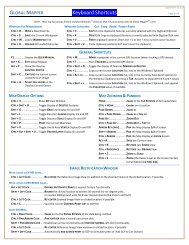Map GPS Coordinates - GPS Map Coordinates ... - Global Mapper
Map GPS Coordinates - GPS Map Coordinates ... - Global Mapper
Map GPS Coordinates - GPS Map Coordinates ... - Global Mapper
Create successful ePaper yourself
Turn your PDF publications into a flip-book with our unique Google optimized e-Paper software.
<strong>Global</strong> <strong>Map</strong>per User's Manual<br />
• FEATHER_BLEND_POLY_FILE (raster only) - specifies that the polygon boundary to feather blend<br />
this layer against should come from the specified file.<br />
• BAND_SETUP (raster only) - specifies what bands of data from the raster file being loaded should be<br />
used to populate the red, green, and blue color channels when displaying the image. This is useful for<br />
multi-spectral imagery which may have more than 3 color bands. The default band setup will be to<br />
use the first three bands as follows: BAND_SETUP="0,1,2". Note that not all raster formats support<br />
specifying a non-default band setup.<br />
• LABEL_FIELD - specifies the name of the attribute field to use as the label attribute for the features<br />
in the file. By default the attribute-based labeling will only be applied to those features that don't<br />
already have a label, but if the LABEL_FIELD_FORCE_OVERWRITE attribute is set to YES then<br />
all features will have their labels replaced.<br />
• LABEL_FIELD_FORCE_OVERWRITE - specifies that the LABEL_FIELD attribute value should<br />
be applied to all feature labels, not just those that don't already have labels. Use<br />
LABEL_FIELD_FORCE_OVERWRITE=YES to enable.<br />
• LABEL_PREFIX - specifies the prefix to prepend to attribute-based labels<br />
• LABEL_SUFFIX - specifies the suffix to append to attribute-based labels<br />
• ELEV_FIELD - specifies the name of the attribute field to use as the elevation value for the features<br />
in the file.<br />
• AREA_TYPE - specifies the name of the <strong>Global</strong> <strong>Map</strong>per type to use for area features imported from<br />
the file.<br />
• LINE_TYPE - specifies the name of the <strong>Global</strong> <strong>Map</strong>per type to use for line features imported from<br />
the file.<br />
• POINT_TYPE - specifies the name of the <strong>Global</strong> <strong>Map</strong>per type to use for point features imported from<br />
the file.<br />
• LAYER_DESC - specifies a description to use for the layer when displaying it in the Overlay Control<br />
Center. This overrides the default description based on the filename or other information within the<br />
file.<br />
• GCP - specifies a single ground control point for use in rectifying a file. The GCP record consists of 5<br />
comma-delimited fields, the control point name, the pixel X and Y coordinates, and the corresponding<br />
ground X and Y coordinates. A separate GCP parameter and value should be used for each control<br />
point used in the rectification. As an alternative, the GCP_FILENAME parameter (see below) can be<br />
used instead.<br />
• GCP_FILENAME - specifies the name of a control point file used to rectify the file being imported.<br />
• GCP_PROJ_NAME - specifies the name of the projection that the ground control points are provided<br />
in. This name must have been defined with a prior DEFINE_PROJ command. Use this if you want to<br />
specify control points in a projection other than what you want to define as the native projection for<br />
the file. Note that you must also explicitly specify the name projection of the file using either the<br />
PROJ_NAME, PROJ_EPSG_CODE or PROJ_FILENAME parameters.<br />
• GCP_PROJ_FILENAME - specifies the name of the projection (.prj) file that contains the projection<br />
definition for the projection that the ground control points are provided in. Use this if you want to<br />
specify control points in a projection other than what you want to define as the native projection for<br />
the file. Note that you must also explicitly specify the name projection of the file using either the<br />
PROJ_NAME, PROJ_EPSG_CODE or PROJ_FILENAME parameters.<br />
• GCP_PROJ_EPSG_CODE - specifies the EPSG code of the projection that the ground control points<br />
are provided in. Use this if you want to specify control points in a projection other than what you want<br />
to define as the native projection for the file. Note that you must also explicitly specify the name<br />
projection of the file using either the PROJ_NAME, PROJ_EPSG_CODE or PROJ_FILENAME<br />
parameters.<br />
• RECTIFY - specifies the rectification method to use for rectifying this file. Valid value are LINEAR,<br />
HELMERT, AFFINE, POLYNOMIAL, and TRIANGULATION. If you do not specify a rectification<br />
type but do provide at least two ground control points, best rectification method will automatically be<br />
<strong>Map</strong> <strong>GPS</strong> <strong>Coordinates</strong> - <strong>GPS</strong> <strong>Map</strong> <strong>Coordinates</strong> - <strong>GPS</strong><strong>Coordinates</strong> <strong>Map</strong> 249







